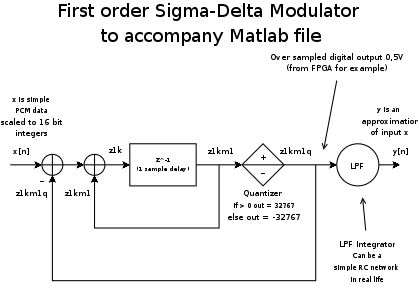UPDATE! Code now bypasses so16() function which would have caused errors for you.
Well here is the first order Sigma-Delta Modulation code for matlab or octave . You will need to download the wav file, or use one of your own that has audio near 16kHz sample rate, and has audio between the first 2000 and 10000 samples. I cannot currently post wav files because wordpress will not let me. If you don’t want to mess with wav’s then you can use the square wave version.
Go to: http://www.dailywav.com/0502.php Right click on the Space Ghost clip (whatsup.wav) file and do a save as to the same directory as the code. I would provide a direct link but they don’t seem to allow hotlinking.
Here is the first order SDM code for a wav file (GNU Octave):
Created with Vim 7.0 command :TOhtml
% firstOrderDSM.m % Implements a first order Sigma-Delta Modulator % Copyright 2007 Brian R Phelps % This program is free software; you can redistribute it and/or modify % it under the terms of the GNU General Public License as published by % the Free Software Foundation; either version 3 of the License, or % (at your option) any later version. % % This program is distributed in the hope that it will be useful, % but WITHOUT ANY WARRANTY; without even the implied warranty of % MERCHANTABILITY or FITNESS FOR A PARTICULAR PURPOSE. See the % GNU General Public License for more details. % % You should have received a copy of the GNU General Public License % along with this program. If not, see http://www.gnu.org/licenses/clear; [x,fs,fmt]=auload('whatsup.wav'); x=x(2000:10000); NumSamps=2000; OSR=10; % The over sampling rate NumSamps=length(x) z1km1q = 0; % Initialize variables z1km1 = 0; % Scale the data to 16 bit "integers", hardware % in real life is integer or fixed point math %returns scaled integers x=round(x*32766); for n=1:NumSamps z1(1)=z1km1; xn=x(n); for k=1:OSR % Each sample is Oversampled OSR times % please see the diagram for an explanation for the following: z1(k) = z1km1; z1km1 = z1(k) + xn - z1km1q; z1km1q = (z1km1 > 0) * 32766 - (z1km1 <= 0) * 32766; y(k+(n-1)*OSR) = (z1km1 > 0) - (z1km1 <= 0); end end b=fir1(121,1/(OSR*2)); % A low pass filter is also an integrator (summer), % either way it is neccessary to recover the original signal y=filter(b,1,y); % This gets rid of the noise, which % most of which is moved out of the passband y=decimate(y,OSR); % Keep only 1/10 samples to get the % sample rate back down to original plot(1:length(y),y ); sound(y/3,fs);

